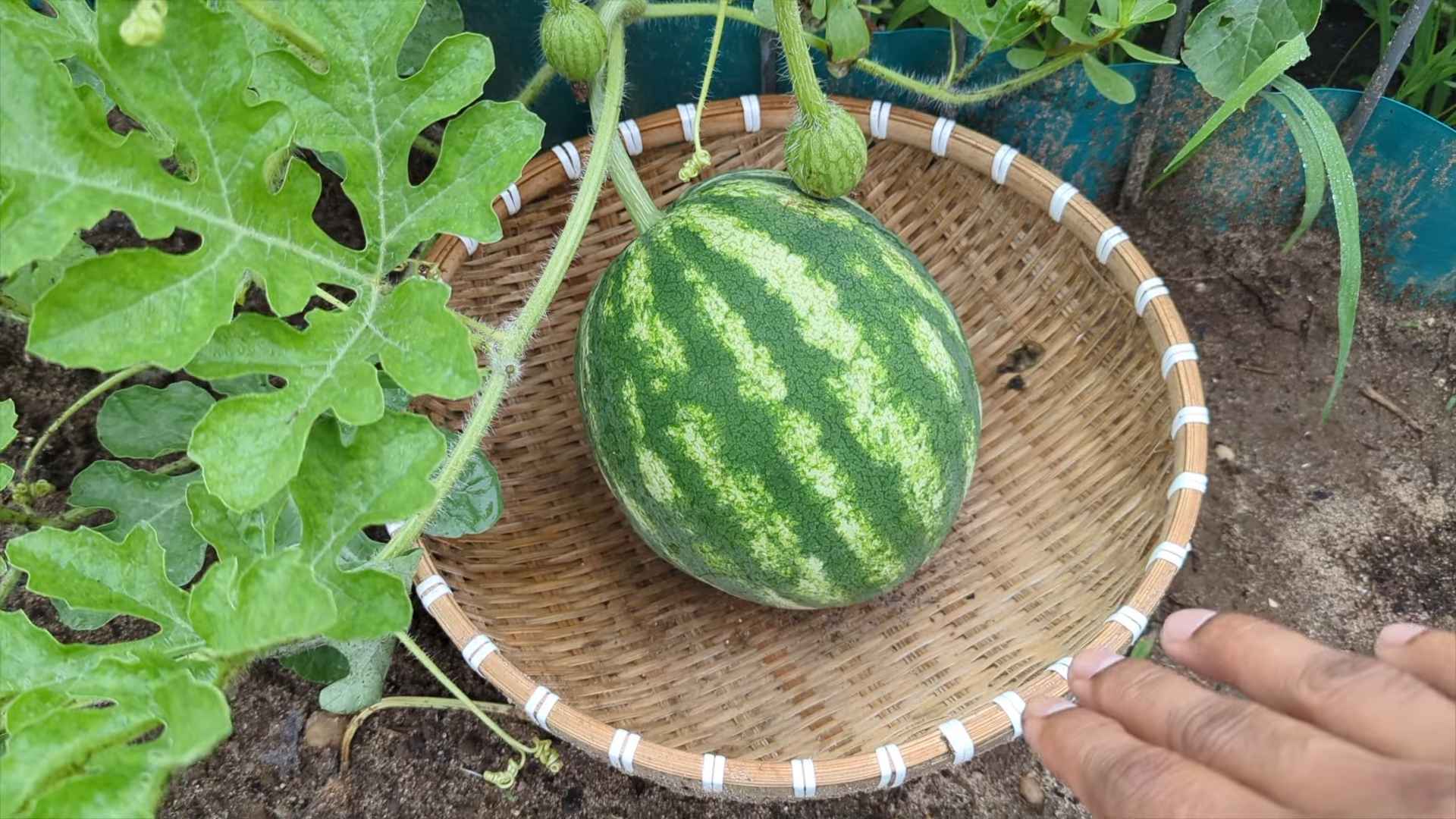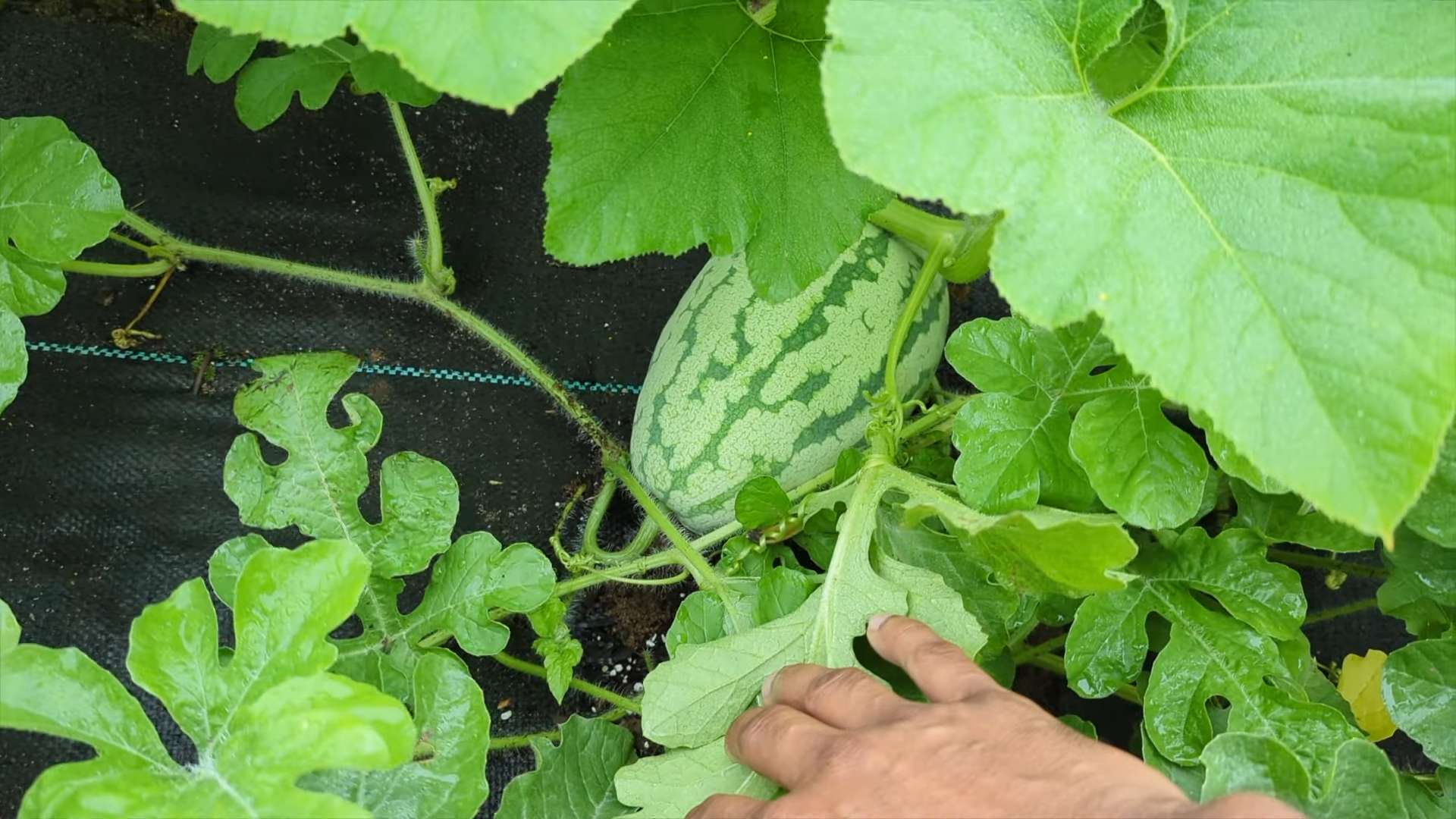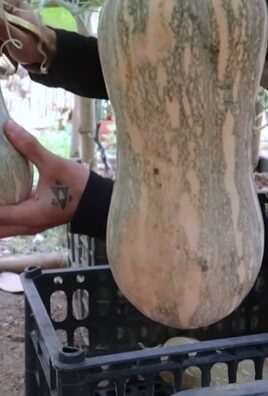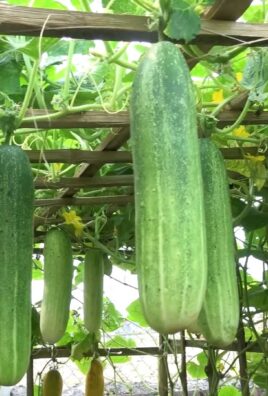Grow Watermelons at Home? Absolutely! Imagine biting into a juicy, sweet watermelon that you nurtured from seed to fruit, right in your own backyard. Forget those bland, store-bought melons – we’re talking about homegrown goodness bursting with flavor. For centuries, watermelons have been a symbol of summer, abundance, and shared joy, enjoyed in cultures around the world. From ancient Egypt, where they were buried with pharaohs, to modern-day picnics, watermelons hold a special place in our hearts (and stomachs!).
But let’s be honest, the thought of growing these giants can be a little intimidating. That’s where this DIY guide comes in! I’m here to show you that you don’t need acres of land or a green thumb of steel to successfully grow watermelons at home. Whether you have a sprawling garden or just a sunny balcony, I’ll share simple, effective tricks and hacks that will make the process fun and rewarding.
Why do you need these DIY tricks? Because growing your own watermelons means fresher, tastier fruit, free from harmful pesticides, and a whole lot of satisfaction. Plus, it’s a fantastic way to connect with nature and impress your friends and family with your gardening prowess. So, let’s dive in and unlock the secrets to growing the perfect watermelon, right in the comfort of your own home!

Growing Watermelons: A Beginner’s Guide to Sweet Success!
Okay, so you want to grow watermelons at home? Awesome! It’s totally doable, and there’s nothing quite like biting into a juicy, homegrown watermelon on a hot summer day. I’m going to walk you through everything you need to know, from choosing the right variety to harvesting your prize-winning melon. Let’s get started!
Choosing Your Watermelon Variety
First things first, you need to pick a watermelon variety that suits your climate and garden space. Some varieties are better suited for shorter growing seasons, while others need a lot of room to sprawl. Here’s a quick rundown of some popular choices:
* Sugar Baby: This is a classic, compact variety that matures quickly (around 75 days). It’s perfect if you have limited space or a shorter growing season. The fruits are typically 8-10 pounds.
* Crimson Sweet: A widely popular, reliable variety known for its sweet, red flesh and good disease resistance. It takes about 85 days to mature and produces larger melons, around 20-25 pounds.
* Jubilee: This is a larger, oblong watermelon with a thick rind, making it good for shipping and storage. It takes about 95 days to mature and can weigh up to 30 pounds.
* Yellow Doll: If you’re looking for something different, try a yellow-fleshed watermelon! Yellow Doll is a small, early-maturing variety (around 70 days) with a sweet, crisp flavor.
* Bush Sugar Baby: If space is a major concern, this bush variety is your best bet. It produces smaller melons on compact vines, making it ideal for container gardening.
Consider your growing season length, available space, and personal preferences when making your choice. Seed packets will provide specific information about each variety.
Preparing Your Garden Bed
Watermelons are heavy feeders and need plenty of sunshine, so site selection and soil preparation are crucial.
* Sunlight: Watermelons need at least 6-8 hours of direct sunlight per day. Choose a location in your garden that gets plenty of sun throughout the day.
* Soil: Watermelons prefer well-drained, sandy loam soil with a pH between 6.0 and 6.8. If your soil is heavy clay, amend it with plenty of compost and other organic matter to improve drainage.
* Nutrients: Watermelons are heavy feeders, so you’ll need to enrich the soil with plenty of nutrients. Work in compost, well-rotted manure, or a balanced fertilizer (like 10-10-10) before planting.
* Space: Give your watermelons plenty of room to sprawl. Most varieties need at least 4-6 feet between plants. Bush varieties can be planted closer together, but still need adequate space for air circulation.
Starting Your Watermelon Seeds
You can either direct sow watermelon seeds in your garden or start them indoors. Starting indoors gives you a head start, especially if you have a short growing season.
* When to Start: Start seeds indoors about 3-4 weeks before the last expected frost.
* Materials: You’ll need seed starting trays or pots, seed starting mix, and a heat mat (optional).
* Sowing Seeds: Plant seeds about 1 inch deep in the seed starting mix. Keep the soil moist but not soggy.
* Germination: Watermelon seeds germinate best at temperatures between 70-85°F (21-29°C). A heat mat can help maintain these temperatures.
* Light: Once the seedlings emerge, provide them with plenty of light. A grow light is ideal, but a sunny windowsill can also work.
* Hardening Off: Before transplanting your seedlings outdoors, you’ll need to harden them off. This means gradually exposing them to outdoor conditions over a period of 7-10 days. Start by placing them in a sheltered location for a few hours each day, gradually increasing the amount of time they spend outdoors.
Transplanting Your Watermelon Seedlings
Once the danger of frost has passed and the soil has warmed up, it’s time to transplant your watermelon seedlings into the garden.
* Timing: Transplant seedlings in the late afternoon or early evening to minimize stress.
* Preparation: Water the seedlings thoroughly before transplanting.
* Planting: Dig a hole that is slightly larger than the root ball of the seedling. Gently remove the seedling from its container and place it in the hole. Backfill with soil and gently firm around the base of the plant.
* Spacing: Space plants according to the variety’s recommendations (usually 4-6 feet apart).
* Watering: Water the newly transplanted seedlings thoroughly.
* Mulching: Apply a layer of mulch around the plants to help retain moisture, suppress weeds, and keep the soil warm. Black plastic mulch is particularly effective for watermelons.
Caring for Your Watermelon Plants
Watermelons need consistent care to thrive and produce sweet, juicy fruits.
* Watering: Water watermelons deeply and regularly, especially during hot, dry weather. Aim for about 1-2 inches of water per week. Avoid overhead watering, as this can promote fungal diseases. Drip irrigation is ideal.
* Fertilizing: Watermelons are heavy feeders, so you’ll need to fertilize them regularly. Use a balanced fertilizer (like 10-10-10) every 2-3 weeks. Once the fruits start to develop, switch to a fertilizer that is higher in potassium to promote sweetness.
* Weeding: Keep the area around your watermelon plants free of weeds. Weeds compete with watermelons for water and nutrients.
* Pest Control: Watermelons can be susceptible to pests like aphids, squash bugs, and cucumber beetles. Inspect your plants regularly and take action if you see any signs of infestation. Insecticidal soap or neem oil can be effective for controlling many common pests.
* Disease Control: Watermelons can also be susceptible to diseases like powdery mildew and fusarium wilt. Choose disease-resistant varieties and practice good sanitation to prevent disease problems. Avoid overhead watering and ensure good air circulation.
* Pollination: Watermelons need to be pollinated in order to produce fruit. Bees are the primary pollinators. If you don’t see many bees in your garden, you may need to hand-pollinate your watermelons. To hand-pollinate, use a small paintbrush to transfer pollen from the male flowers to the female flowers. Female flowers have a small, immature watermelon at the base of the flower.
Training Your Watermelon Vines
Watermelon vines can sprawl quite a bit, so you may need to train them to keep them from taking over your garden.
* Pruning: You can prune watermelon vines to encourage fruit production. Remove any suckers (small shoots that grow from the base of the plant) and any dead or diseased leaves.
* Support: If you’re growing watermelons in a small space, you can train the vines up a trellis or fence. This will help save space and improve air circulation.
* Fruit Support: As the watermelons grow larger, you may need to support them to prevent them from breaking off the vine. You can use slings made from old pantyhose or netting to support the fruits.
Harvesting Your Watermelons
Knowing when to harvest your watermelons is key to getting that perfect, sweet flavor. It’s not always easy to tell when a watermelon is ripe, but here are a few things to look for:
* Days to Maturity: Check the seed packet for the variety’s days to maturity. This will give you a general idea of when to expect your watermelons to be ripe.
* Tendril: The tendril closest to the watermelon should be brown and dry.
* Ground Spot: The ground spot (the area where the watermelon rests on the ground) should be yellow or cream-colored.
* Thumping: Thump the watermelon. A ripe watermelon will sound hollow.
* Rind: The rind should be dull and waxy, not shiny.
Once you think your watermelon is ripe, carefully cut it from the vine with a sharp knife or pruning shears. Leave a few inches of stem attached.
Enjoying Your Homegrown Watermelon
Congratulations! You’ve successfully grown your own watermelons. Now it’s time to enjoy the fruits (or rather, the melons) of your labor.
* Storage: Whole watermelons can be stored at room temperature for a week or two. Cut watermelons should be stored in the refrigerator.
* Serving: Watermelon is delicious on its own, but it can also be used in salads, smoothies, and other recipes.
* Seed Saving: If you want to save seeds from your watermelons for

Conclusion
So, there you have it! Growing watermelons at home might seem daunting at first, but with a little planning, patience, and the right techniques, you can be harvesting your own juicy, sweet watermelons before you know it. This isn’t just about saving money at the grocery store; it’s about experiencing the satisfaction of nurturing a plant from seed to fruit, connecting with nature, and enjoying the unparalleled flavor of a homegrown watermelon.
This DIY approach to watermelon cultivation offers a unique opportunity to tailor the growing process to your specific environment and preferences. Whether you’re dealing with limited space, challenging soil conditions, or simply want to experiment with different varieties, there’s a way to make it work.
Consider these variations to personalize your watermelon growing journey:
* Vertical Watermelon Gardening: If space is a constraint, explore vertical gardening techniques. Train your watermelon vines to climb a trellis or fence. This not only saves space but also improves air circulation around the plant, reducing the risk of fungal diseases. Just be sure to provide adequate support for the heavy fruits as they develop.
* Container Gardening: Choose a large container (at least 20 gallons) and a dwarf or bush watermelon variety. Ensure the container has excellent drainage and use a high-quality potting mix. Container gardening allows you to move your watermelon plant to the sunniest spot in your yard or even indoors during unexpected cold snaps.
* Grafting for Disease Resistance: If you’ve struggled with soilborne diseases in the past, consider grafting your watermelon scion onto a disease-resistant rootstock, such as a squash or gourd. This can significantly improve the health and vigor of your plant.
* Experiment with Varieties: Don’t limit yourself to the standard red-fleshed watermelons. Explore different varieties like yellow watermelons, seedless watermelons, or heirloom varieties with unique flavors and textures. Each variety has its own characteristics and growing requirements, so do your research before planting.
* Companion Planting: Enhance your watermelon patch by incorporating companion plants. Marigolds can deter pests, while herbs like basil and oregano can attract beneficial insects. Companion planting can create a healthier and more productive growing environment.
The key to successful watermelon cultivation lies in understanding the plant’s needs and adapting your approach accordingly. Remember to provide ample sunlight, water, and nutrients, and protect your plants from pests and diseases.
We truly believe that anyone can successfully grow watermelons at home with the right guidance and a little bit of effort. So, grab your seeds, prepare your soil, and get ready to embark on a rewarding gardening adventure.
We’re eager to hear about your experiences! Share your tips, tricks, and photos in the comments below. Let’s create a community of watermelon enthusiasts and learn from each other. What variety did you choose? What challenges did you face, and how did you overcome them? Your insights could be invaluable to other aspiring watermelon growers. Happy gardening!
Frequently Asked Questions (FAQ)
How much space do watermelons need to grow?
Watermelons are sprawling plants that require a significant amount of space. Generally, you’ll need at least 6-8 feet between plants in a row and 8-10 feet between rows. Dwarf or bush varieties can be grown in smaller spaces, but even they need at least 3-4 feet of space. Consider vertical gardening techniques if you have limited space.
What kind of soil is best for growing watermelons?
Watermelons thrive in well-drained, sandy loam soil that is rich in organic matter. The ideal soil pH is between 6.0 and 6.8. Before planting, amend your soil with compost or well-rotted manure to improve its fertility and drainage. Avoid heavy clay soils, as they can become waterlogged and inhibit root growth.
How often should I water my watermelon plants?
Watermelons need consistent moisture, especially during fruit development. Water deeply and regularly, aiming for about 1-2 inches of water per week. Avoid overhead watering, as this can promote fungal diseases. Use a soaker hose or drip irrigation to deliver water directly to the roots. Reduce watering as the fruits ripen to prevent them from splitting.
How much sunlight do watermelons need?
Watermelons require at least 6-8 hours of direct sunlight per day to produce sweet, juicy fruits. Choose a planting location that receives full sun throughout the growing season. If you live in a cloudy area, consider using grow lights to supplement natural sunlight.
When is the best time to plant watermelon seeds?
Watermelons are warm-season crops that should be planted after the last frost when the soil temperature has reached at least 70°F (21°C). You can start seeds indoors 4-6 weeks before the last frost and transplant them outdoors once the weather is warm enough. In warmer climates, you can direct sow seeds into the garden.
How long does it take for watermelons to mature?
The time it takes for watermelons to mature varies depending on the variety and growing conditions. Generally, it takes 70-90 days from planting to harvest. Check the seed packet or plant tag for specific maturity dates.
How do I know when a watermelon is ripe?
There are several indicators that a watermelon is ripe:
* The tendril closest to the fruit turns brown and dries up.
* The underside of the watermelon (where it rests on the ground) turns from white to yellow.
* The watermelon sounds dull and hollow when you thump it.
* The skin of the watermelon becomes dull and loses its shine.
What are some common pests and diseases that affect watermelons?
Common pests that affect watermelons include aphids, squash bugs, cucumber beetles, and vine borers. Common diseases include powdery mildew, fusarium wilt, and anthracnose. Use organic pest control methods, such as insecticidal soap or neem oil, to control pests. Choose disease-resistant varieties and practice good sanitation to prevent diseases.
Do I need to pollinate my watermelon plants?
Watermelons require pollination to produce fruit. Bees are the primary pollinators of watermelons. Attract bees to your garden by planting flowering herbs and vegetables. If you’re not seeing enough bee activity, you can hand-pollinate your watermelon flowers. To hand-pollinate, use a small paintbrush to transfer pollen from the male flowers to the female flowers.
Can I grow watermelons in containers?
Yes, you can grow watermelons in containers, but you’ll need to choose a large container (at least 20 gallons) and a dwarf or bush watermelon variety. Ensure the container has excellent drainage and use a high-quality potting mix. Container-grown watermelons will need more frequent watering and fertilization than those grown in the ground.
What kind of fertilizer should I use for watermelons?
Watermelons need a balanced fertilizer with equal amounts of nitrogen, phosphorus, and potassium. Use a fertilizer with an NPK ratio of 10-10-10 or 14-14-14. Apply fertilizer at planting and then again when the vines begin to run and when the fruits begin to set. Avoid over-fertilizing, as this can lead to excessive vine growth and reduced fruit production.
How can I prevent my watermelons from cracking?
Watermelon cracking can be caused by inconsistent watering, especially after a period of drought. To prevent cracking, water your watermelons regularly and deeply, especially during fruit development. Mulch around the plants to help retain moisture in the soil. Avoid over-fertilizing, as this can also contribute to cracking.
What are some good companion plants for watermelons?
Good companion plants for watermelons include marigolds, basil, oregano, nasturtiums, and radishes. Marigolds deter pests, while herbs like basil and oregano attract beneficial insects. Nasturtiums attract aphids away from watermelon plants, and radishes can help break up compacted soil.
Can I save seeds from my watermelons to plant next year?
Yes, you can save seeds from your watermelons to plant next year, but only if you’re growing open-pollinated varieties. Hybrid varieties will not produce true-to-type seeds. To save seeds, scoop out the seeds from a ripe watermelon and rinse them thoroughly. Spread the seeds out on a paper towel to dry completely. Store the dried seeds in an airtight container in a cool, dry place.





Leave a Comment